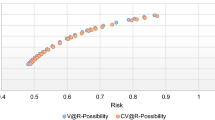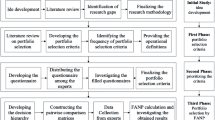Abstract
In financial markets, there are various assets to invest in. Recognizing an investor’s preferences is key to selecting a combination of assets that best serves his or her needs. Considering the mean–variance model for the portfolio optimization problem, this paper proposes an interactive multicriteria decision-making method and explores a self-adaptive preference model based on dynamic feature analysis (denoted RFFS-DT) to capture the decision maker (DM)’s complex preferences in the decision-making process. RFFS-DT recognizes the DM’s preference impact factor and constructs a preference model. To recognize the impact factors of the DM’s preferences, which could change during the decision-making process, three categories of possible features involved in three aspects of the mean–variance model are defined, and a feature selection method based on random forest is designed. Because the DM’s preference structure could be unknown a priori, a decision-tree-based preference model is built and updated adaptively according to the DM’s preference feedback and the selected features. The effectiveness of RFFS-DT for interactive multicriteria decision making is verified by a series of deliberately designed comparative experiments.






Similar content being viewed by others
References
Markowitz H (1952) Portfolio selection. J Financ 7(1):77–91
Markowitz H (1959) Portfolio selection: efficient diversification of investments. John Wiley and Sons, New York
Deb K, Pratap A, Agarwal S, Meyarivan T (2002) A fast and elitist multi-objective genetic algorithm: NSGA-II. IEEE Trans Evol Comput 6(2):182–197
Zhang Q, Li H (2007) MOEA/D: a multi-objective evolutionary algorithm based on decomposition. IEEE Trans Evol Comput 11(6):712–731
Xin B, Chen L, Chen J, Ishibuchi H, Hirota K, Liu B (2018) Interactive multiobjective optimization: a review of the state-of-the-art. IEEE Access 6:41256–41279
Bonissone PP, Subbu R, Lizzi J (2009) Multi-criteria decision making: a framework for research and applications. IEEE Comput Intell Mag 4(3):48–61
Ozbey O, Karwan MH (2014) An interactive approach for multicriteria decision making using a Tchebycheff Utility function approximation. J Multi-Criteria Decis Anal 21(3–4):153–172
Ruiz AB, Saborido R, Luque M (2015) A preference-based evolutionary algorithm for multi-objective optimization: the weighting achievement scalarizing function genetic algorithm. J Global Optim 62(1):101–129
Li L, Wang Y, Trautmann H, Jing N, Emmerich M (2018) Multi-objective evolutionary algorithms based on target region preferences. Swarm Evol Comput 40:196–215
Li L, Yevseyeva I, Basto-Fernandes V, Trautmann H, Jing N (2017) Building and using an ontology of preference-based multiobjective evolutionary algorithms. Int Conf Evol Multi-Criterion Optim 10173:406–421
Köksalan M, Wallenius J, Zionts S (2013) An early history of multiple criteria decision making. J Multi-Criteria Decis Anal 20(1–2):87–94
Phelps SP, Koksalan M (2003) An interactive evolutionary metaheuristic for multi-objective combinatorial optimization. Manag Sci 49(12):1726–1738
Branke J, Corrente S, Greco S, Słowi´nski R, Zielniewicz P (2016) Using choquet integral as preference model in interactive evolutionary multiobjective optimization. Eur J Oper Res 250(3):884–901
Pedro LR, Takahashi RHC (2014) INSPM: an interactive evolutionary multi-objective algorithm with preference model. Inf Sci 268(1):202–219
Greco S, Ehrgott M, Figueira JR (2016) Multiple criteria decision analysis state of the art surveys. Springle, New York
Miettinen K, Mäkelä MM (2002) On scalarizing functions in multiobjective optimization. OR Spectr 24(2):193–213
Deb K, Sundar J (2006) Reference point based multi-objective optimization using evolutionary algorithms. Proceedings of the 8th ACM annual conference on Genetic and evolutionary computation pp. 635–642
Klamroth K, Miettinen K (2008) Integrating approximation and interactive decision making in multicriteria optimization. Oper Res 56(1):222–234
Wang R, Purshouse RC, Fleming PJ (2013) Preference-inspired coevolutionary algorithms for many-objective optimization. IEEE Trans Evol Comput 17(4):474–494
Goulart F, Campelo F (2016) Preference-guided evolutionary algorithms for many-objective optimization. Inf Sci 329:236–255
Miettinen K, Mäkelä MM (2006) Synchronous approach in interactive multi-objective optimization. Eur J Oper Res 170(3):909–922
Miettinen K, Mäkelä MM, Kaario K (2006) Experiments with classification-based scalarizing functions in interactive multi-objective optimization. Eur J Oper Res 175(2):931–947
Luque M, Miettinen K, Eskelinen P, Ruiz F (2009) Incorporating preference information in interactive reference point methods for multi-objective optimization. Omega 37(2):450–462
Vallerio M, Hufkens J, Van IJ, Logist F (2015) An interactive decision-support system for multi-objective optimization of nonlinear dynamic processes with uncertainty. Expert Syst Appl 42(21):7710–7731
Battiti R, Passerini A (2010) Brain-computer evolutionary multi-objective optimization: a genetic algorithm adapting to the decision maker. IEEE Trans Evol Comput 14(5):671–687
Larichev O (1992) Cognitive validity in design of decision aiding techniques. J Multi-Criteria Decis Anal 1(3):127–138
Pascoletti A, Serafini P (1984) Scalarizing vector optimization problems. J Optim Theory Appl 42(4):499–524
Deb K, Sinha A, Korhonen PJ, Wallenius J (2010) An interactive evolutionary multi-objective optimization method based on progressively approximated value functions. IEEE Trans Evol Comput 14(5):723–739
Mukhlisullina D, Passerini A, Battiti R (2013) Learning to diversify in complex interactive multi-objective optimization. Proceedings of the 10th Metaheuristics International Conference, Singapore Management University pp. 230–239
Sun M, Stam A, Steuer RE (2000) Interactive multiple objective programming using tchebycheff programs and artificial neural networks. Comput Oper Res 27(7):601–620
Sun M, Stam A, Steuer RE (1996) Solving multiple objective programming problems using feed-forward artificial neural networks: the interactive FFANN procedure. Manag Sci 42(6):835–849
Huang HZ, Tian Z, Zuo MJ (2005) Intelligent interactive multi-objective optimization method and its application to reliability optimization. IIE Trans 37(11):983–993
Zhang H, Llorca J, Davis CC et al (2012) Nature-inspired self-organization, control, and optimization in heterogeneous wireless networks. IEEE Trans Mob Comput 11(7):1207–1222
Zhang H, Cao X, Ho JKL et al (2017) Object-level video advertising: an optimization framework. IEEE Trans Industr Inf 13(2):520–531
Qamar N, Akhtar N, Younas I (2018) Comparative analysis of evolutionary algorithms for multi-objective travelling salesman problem. Int J Adv Comput Sci Appl 9(2):371–379
Masmoudi M, Abdelaziz FB (2018) Portfolio selection problem: a review of deterministic and stochastic multiple objective programming models. Ann Oper Res 267(1–2):335–352
Källblad S (2017) Risk-and ambiguity-averse portfolio optimization with quasicon-cave utility functionals. Financ Stoch 21(2):397–425
Lwin KT (2015) Evolutionary approaches for portfolio optimization. Dissertation, University of Nottingham
Gutjahr WJ, Pichler A (2016) Stochastic multi-objective optimization: a survey on non-scalarizing methods. Ann Oper Res 236(2):475–499
Brucker P, Knust S (2012) Resource-constrained project scheduling in: complex scheduling. GOR-Publications
Miettinen K, Ruiz F, Wierzbicki AP (2008) Introduction to multiobjective optimization: interactive approaches. In: Multiobjective Optimization, pp 27–57
Breiman L (2001) Random forests. Mach Learn 45(1):5–32
Biau G, Devroye L, Lugosi G (2008) Consistency of random forests and other averaging classifiers. J Mach Learn Res 9(1):2015–2033
Mentch L, Hooker G (2014) Quantifying uncertainty in random forests via confidence intervals and hypothesis tests. J Mach Learn Res 17(1):841–881
Verikas A, Gelzinis A, Bacauskiene M (2011) Mining data with random forests: a survey and results of new tests. Pattern Recogn 44(2):330–349
Marill T, Green D (1963) On the effectiveness of receptors in recognition systems. IEEE Trans Inf Theory 9(1):11–17
Grabczewski K (2014) Meta-learning in decision tree induction. Springer International Publishing, Berlin
Safavin SR, Landgrebe D (1991) A survey of decision tree classifier methodology. IEEE Trans Syst Man Cybern 21(3):660–674
Zhang H, Singer BH (2010) Recursive partitioning and applications. Springer, New York
Breiman L, Friedman J, Olshen R, Stone C (1984) Classification and regression trees. Chapman & Hall, New York
Wang R, Kwong S, Wang XZ, Jiang QS (2015) Segment based decision tree induction with continuous valued attributes. IEEE Trans Cybern 45(7):1262–1275
Bosman PAN, Thierens D (2003) The balance between proximity and diversity in multi-objective evolutionary algorithms. IEEE Trans Evol Comput 7(2):174–188
Fowler JW, Gel ES, Koksalan MM, Korhonen P, Marquis JL, Wallenius J (2010) Interactive evolutionary multi-objective optimization for quasi-concave preference functions. Eur J Oper Res 206(2):417–425
Sinha A, Korhonen P, Wallenius J, Deb K (2010) An interactive evolutionary multi-objective optimization method based on polyhedral cones. Learn Intell Optim 6073(3):318–332
Koksalan M, Karahan I (2010) An interactive territory defining evolutionary algorithm: iTDEA. IEEE Trans Evol Comput 14(5):702–722
Goulart F, Campelo F (2016) Preference-guided evolutionary algorithms for many-objective optimization. Inf Sci 329:236–255
Saaty TL, Vargas LG (2017) Models, methods, concepts & applications of the analytic hierarchy process. International 7(2):159–172
Wang R, Wang XZ, Kwong S, Xu C (2017) Incorporating diversity and informativeness in multiple-instance active learning. IEEE Trans Fuzzy Syst 25(6):1460–1475
Du B, Wang ZM, Zhang LF, Zhang LP, Liu W, Shen JL, Tao DC (2015) Exploring representativeness and informativeness for active learning. IEEE Trans Cybern 47(1):1–13
Wang R, Chow CY, Kwong S (2016) Ambiguity based multiclass active learning. IEEE Trans Fuzzy Syst 24(1):242–248
Samat A, Gamba P, Liu SC (2018) Fuzzy multiclass active learning for hyperspectral image classification. IET Image Proc 12(7):1–7
Wang XZ, Wang R, Xu C (2018) Discovering the relationship between generalization and uncertainty by incorporating complexity of classification. IEEE Trans Cybern 48(2):703–715
Wang XZ, Xing HJ, Li Y, Hua Q, Dong CR, Pedrycz W (2015) A study on relationship between generalization abilities and fuzziness of base classifiers in ensemble learning. IEEE Trans Fuzzy Syst 23(5):1638–1854
Acknowledgments
The authors thank the referee for his or her comments on the manuscript. This work was supported in part by the NSFS under Grant No. ZR2016FM27and by the NSFC under Grant No. 61702139.
Author information
Authors and Affiliations
Corresponding author
Additional information
Publisher's Note
Springer Nature remains neutral with regard to jurisdictional claims in published maps and institutional affiliations.
Appendix
Rights and permissions
About this article
Cite this article
Hu, S., Li, F., Liu, Y. et al. A self-adaptive preference model based on dynamic feature analysis for interactive portfolio optimization. Int. J. Mach. Learn. & Cyber. 11, 1253–1266 (2020). https://doi.org/10.1007/s13042-019-01036-y
Received:
Accepted:
Published:
Issue Date:
DOI: https://doi.org/10.1007/s13042-019-01036-y




